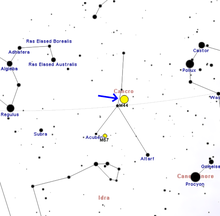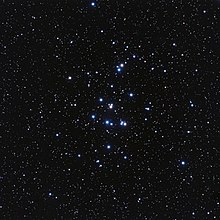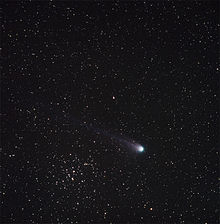鬼宿星團
| M 44 /鬼宿星團(蜂巢星團) | |
|---|---|
 在巨蟹座的鬼宿星團(北方在右邊),裸眼剛好能看得見它。 | |
| 觀測資料 (J2000.0 曆元) | |
| 星座 | 巨蟹座 |
| 赤經 | 08h 40.4m |
| 赤緯 | 19° 59′ |
| 距離 | 610 ly[1] (187 pc) |
| 視星等 (V) | 3.7[2] |
| 視大小 (V) | 95′ |
| 物理特徵 | |
| 質量 | ~500–600 M☉ |
| 估計年齡 | ~6–7億年 |
| 其他特徵 | Praesepe, M44, NGC 2632, Cr 189 |

鬼宿星團也稱為蜂巢星團(英語:Beehive Cluster)、M44、NGC 2632、或Cr 189、拉丁語中的「馬槽」、「嬰兒床」Praesepe。它是在巨蟹座的一個疏散星團。它是最靠近地球的疏散星團之一,包含的恆星數量比附近其它明亮的疏散星團多,大約有1,000顆恆星。在黑暗的天空下,鬼宿星團在肉眼看來就像一個小的斑塊,因此自古以來就為人所知。古代的天文學家托勒密將其描述為「巨蟹座胸口中的一個模糊團塊」,中國稱他為「積尸氣」。它也是伽利略用他的望遠鏡研究的第一批天體之一[3]。與畢宿星團一致的年齡和自行,表明它們可能具有相似的起源[4][5]。這兩個星團還包含紅巨星和白矮星,以及許多主序列恆星,這代表已經在恆星演化的後期階段。
到鬼宿星團的距離通常被認為在160到187 秒差距(520–610 光年)之間[6][7][8], 但是鬼宿星團成員的依巴谷衛星視差修訂版(2009年)和最新的紅外顏色-光度圖傾向於182秒差距的距離[9][10]。更好的年齡估計約為 6 億年[5][7][11]。(相比之下,畢宿星團大約有 6.25 億年)[12]。明亮的內星團核心直徑約為7.0秒差距(23 光年)[11]。
該星團的視直徑為1.5°,很適合雙筒望遠鏡或低倍小型望遠鏡的視野。軒轅十四、北河二和北河三都是尋找鬼宿星團的導引星
歷史
[编辑]1609年,伽利略首次用望遠鏡觀測鬼宿星團,並將其分解為40顆恆星。 1769年,梅西耶在精確的測量它在天空中的位置後,將它加入他的著名目錄中。大多數的梅西耶天體都是黯淡而且容易與彗星混淆的天體,但是獵戶座大星雲(M42,M43)、昴宿星團(M45)和鬼宿星團(M44)也在目錄中,實在令人好奇。一種可能性是梅西耶想超越它的競爭對手,拉卡伊。因為後者在1755年的星表已經包含42個天體,所以他添加了這些著名的明亮天體來擴充他的星表[13]。1894年,格丁根天文台的台長,威廉·舒爾繪製了該星團的星圖。

古代希臘人與羅馬人將鬼宿星團視為2隻驢子的食槽,相鄰的鬼宿三(巨蟹座γ星)及鬼宿四(巨蟹座δ星)則代表這2隻驢子,牠們也是戴奧尼索斯與西勒諾斯(Silenus)踏上討伐泰坦旅途上的坐騎[14]。
喜帕恰斯(西元前130年)在他的星表中稱這個星團是「小小的雲」(「Nephelion」)[15]。托勒密的天文學大成中包括7個「星雲」(其中4個是真實的星雲),鬼宿星團即為其中之一[16]),將其描述為「巨蟹胸部的星雲狀腫塊」[17]。亞拉(西元前260-270年)在他的詩歌《Phainomena》中描述這個星團為像「小霧」(或「Achlus」)[15]。
1603年,約翰·拜耳在他的圖集《測天圖》上將該星團顯示為一顆星雲狀恆星,並將其標記為ε。這個標示現在專門用於星團中最亮的恆星巨蟹座ε,其星等為6.29[18]。
在中國,這個模糊的斑塊位於28宿的第23宿,鬼宿。28宿是國古天文學使用的星空劃分,類似於黃道星座。中國古代的天文學家認為這是魂魄或魔鬼乘坐的馬車,而其外觀如同柳絮與其種子般飄逸,柔弱而沒有活力,因此被稱為帶有些許禪意的「積尸氣」[15];它也會被簡稱為「積尸」(累積的屍體)。
組織和成分
[编辑]像許多各種各樣的星團一樣,鬼宿星團也經歷過質量層化[7][11][19]。這意味著明亮的大質量恆星集中在星團的核心,而較暗和質量較小的恆星則填充在其暈(有時稱為「冕」)中。該星團的核心半徑估計為3.5秒差距(11.4光年);其半質量半徑約為3.9秒差距(12.7光年);其潮汐半徑約為12秒差距(39光年)[7][11]。然而,潮汐半徑還包括許多僅僅「穿過」而不是星團「真正」成員的恆星。

該星團總共包含至少1,000顆受引力束縛的恆星,總質量約為500-600太陽質量[7][11]。最近的一項調查統計了1,010個高概率成員,其中68%是M矮星,30%是光譜類別F、G和K的類日恆星,約2%是光譜類別A的明亮恆星[7]。此外,還有五顆巨星,其中四顆光譜等級為K0 III,第五顆為G0 III[4][7][20]。
到目前為止,已經確定了11顆白矮星,代表了該星團最大質量恆星的最後進化階段,這些恆星最初屬於光譜類型B[5]。然而,棕矮星在這個星團中很少見[21],可能是因為它們被暈上的潮汐剝離而消失了[7]。在AD 3116的食聯星系統中發現了一顆棕矮星[22]。
該星團的視覺亮度為3.7等。它最亮的恆星是藍白色的,星等為6至6.5等。積尸增二(巨蟹座42)是已確認的成員。

行星
[编辑]2012年9月,在蜂巢星團中發現了兩顆圍繞不同恆星運行的行星。這一發現具有重要意義,因為它是第一顆被探測到像地球的太陽:圍繞位於星團中的恒星運行的行星[23]。
行星已被命名為Pr0201 b和Pr0211 b。它們名稱末尾的「b」表示這些天體是行星。發現的這兩顆行星都是熱木星,是巨大的氣態巨行星,與太陽系的行星木星不同,它們的軌道非常靠近母恒星[23]。
由山姆·奎因(英語:Sam Quinn)作為第一作者撰寫,以信函的形式描述行星發現的公告發表在《天文物理期刊》。奎因的團隊與哈佛-史密松天體物理中心的大衛·萊瑟姆(英語:David Latham)合作,使用史密松天體物理台的弗雷德·勞倫斯·惠普爾天文台[23][24]。
2016年,進一步的觀測發現了Pr0211系統中的第二顆行星Pr0211 c。這使得Pr0211成為在疏散星團中發現的第一個多行星系統[25]。
克卜勒太空望遠鏡在其K2任務中,發現了更多圍繞蜂巢星團中恒星的行星。這些恆星是K2-95[26]、K2-100、K2-101、K2-102、K2-103、和K2-104[27]。每個恆星系都有一顆行星,而 K2-264有一個雙行星系統[28]。
相關條目
[编辑]參考資料
[编辑]- ^ NGC 2632. sim-id. [2020-06-11]. (原始内容存档于2023-04-08).
- ^ Messier 44. SEDS. [2009-12-10]. (原始内容存档于2015-03-12).
- ^ Messier 44: Observations and Descriptions. [2015-06-07]. (原始内容存档于2016-04-13).
- ^ 4.0 4.1 Klein-Wassink, W.J. The proper motion and the distance of the Praesepe cluster. Publications of the Kapteyn Astronomical Laboratory Groningen. 1927, 41: 1–48. Bibcode:1927PGro...41....1K.
- ^ 5.0 5.1 5.2
Dobbie PD; Napiwotzki R; Burleigh MR; et al. New Praesepe white dwarfs and the initial mass-final mass relation. Monthly Notices of the Royal Astronomical Society. 2006, 369 (1): 383–389. Bibcode:2006MNRAS.369..383D. S2CID 17914736. arXiv:astro-ph/0603314
 . doi:10.1111/j.1365-2966.2006.10311.x
. doi:10.1111/j.1365-2966.2006.10311.x  .
.
- ^
Pinfield DJ; Dobbie PD; Jameson F; Steele IA; et al. Brown dwarfs and low-mass stars in the Pleiades and Praesepe: Membership and binarity. Monthly Notices of the Royal Astronomical Society. 2003, 342 (4): 1241–1259. Bibcode:2003MNRAS.342.1241P. S2CID 285922. arXiv:astro-ph/0303600
 . doi:10.1046/j.1365-8711.2003.06630.x
. doi:10.1046/j.1365-8711.2003.06630.x  .
.
- ^ 7.0 7.1 7.2 7.3 7.4 7.5 7.6 7.7
Kraus AL; Hillenbrand LA. The stellar populations of Praesepe and Coma Berenices. Astronomical Journal. 2007, 134 (6): 2340–2352. Bibcode:2007AJ....134.2340K. S2CID 15945900. arXiv:0708.2719
 . doi:10.1086/522831.
. doi:10.1086/522831.
- ^ WEBDA. [2015-06-07]. (原始内容存档于2012-09-20).
- ^ van Leeuwen, F. "Parallaxes and proper motions for 20 open clusters as based on the new Hipparcos catalogue" (页面存档备份,存于互联网档案馆), A&A, 2009
- ^ Majaess, D.; Turner, D.; Lane, D.; Krajci, T. "Deep Infrared ZAMS Fits to Benchmark Open Clusters Hosting delta Scuti Stars" (页面存档备份,存于互联网档案馆), Journal of the American Association of Variable Star Observers, 2011
- ^ 11.0 11.1 11.2 11.3 11.4
Adams JD; Stauffer JR; Skrutskie MF; et al. Structure of the Praesepe Star Cluster. Astronomical Journal. 2002, 124 (3): 1570–1584. Bibcode:2002AJ....124.1570A. doi:10.1086/342016
 .
.
- ^
Perryman M; Brown A; Lebreton Y; Gomez A; Turon C; Cayrel de Strobel G; et al. The Hyades: Distance, structure, dynamics, and age. Astronomy & Astrophysics. 1998, 331: 81–120. Bibcode:1998A&A...331...81P. arXiv:astro-ph/9707253
 .
.
- ^ Frommert, Hartmut. Messier Questions & Answers. SEDS. 1998 [2005-03-01]. (原始内容存档于9 February 2005).
- ^ M44. SEDS. [2005-02-06]. (原始内容存档于2015-03-12).
- ^ 15.0 15.1 15.2 Allen, Richard Hinckley. Star Names. 1889: 112 [2015-06-08]. (原始内容存档于2021-02-11).
- ^ The Discovery of the Deep Sky Objects. [2015-06-08]. (原始内容存档于2020-09-27).
- ^ Messier Object 44. SEDS. [2013-09-28]. (原始内容存档于2015-03-12).
- ^ Cancer – the asses and the Manger. Star Tales (online edition). [2023-11-19]. (原始内容存档于2024-05-24).
- ^
Portegies Zwart SF; McMillan SL; Hut P; Makino J. Star cluster ecology IV. Dissection of an open star cluster: Photometry. Monthly Notices of the Royal Astronomical Society. 2001, 321 (2): 199–226. Bibcode:2001MNRAS.321..199P. S2CID 18396503. arXiv:astro-ph/0005248
 . doi:10.1046/j.1365-8711.2001.03976.x
. doi:10.1046/j.1365-8711.2001.03976.x  .
.
- ^
Abt HA; Willmarth DW. Binaries in the Praesepe and Coma star clusters and their implications for binary evolution. Astrophysical Journal. 1999, 521 (2): 682–690. Bibcode:1999ApJ...521..682A. S2CID 119772785. doi:10.1086/307569
 .
.
- ^
Gonzalez-Garcia BM; Zapatero Osorio MR; Bejar VJS; Bihain G; et al. A search for substellar members in the Praesepe and Sigma Orionis clusters. Astronomy & Astrophysics. 2006, 460 (3): 799–810. Bibcode:2006A&A...460..799G. S2CID 119376131. arXiv:astro-ph/0609283
 . doi:10.1051/0004-6361:20065909.
. doi:10.1051/0004-6361:20065909.
- ^ Gillen, Edward; Hillenbrand, Lynne A.; et al. New Low-mass Eclipsing Binary Systems in Praesepe Discovered by K2. The Astrophysical Journal. November 2017, 849 (1): 11. Bibcode:2017ApJ...849...11G. arXiv:1706.03084
 . doi:10.3847/1538-4357/aa84b3
. doi:10.3847/1538-4357/aa84b3  .
.
- ^ 23.0 23.1 23.2 Quinn, Samuel N.; White, Russel J.; et al. Two "b"s in the Beehive: The Discovery of the First Hot Jupiters in an Open Cluster. The Astrophysical Journal Letters. September 2012, 756 (2): L33. Bibcode:2012ApJ...756L..33Q. S2CID 118825401. arXiv:1207.0818
 . doi:10.1088/2041-8205/756/2/L33.
. doi:10.1088/2041-8205/756/2/L33.
- ^ First Planets Found Around Sun-Like Stars in a Cluster. Jet Propulsion Laboratory. [September 14, 2012]. (原始内容存档于2020-11-12).
- ^ Malavolta, L.; Nascimbeni, V.; et al. The GAPS programme with HARPS-N at TNG. XI. Pr 0211 in M 44: the first multi-planet system in an open cluster. Astronomy & Astrophysics. April 2016, 588: A118. Bibcode:2016A&A...588A.118M. S2CID 119207951. arXiv:1602.00009
 . doi:10.1051/0004-6361/201527933.
. doi:10.1051/0004-6361/201527933.
- ^ Obermeier, Christian; Henning, Thomas; et al. K2 Discovers a Busy Bee: An Unusual Transiting Neptune Found in the Beehive Cluster. The Astronomical Journal. December 2016, 152 (6): 223. Bibcode:2016AJ....152..223O. arXiv:1608.04760
 . doi:10.3847/1538-3881/152/6/223
. doi:10.3847/1538-3881/152/6/223  .
.
- ^ Mann, Andrew W.; Gaidos, Eric; et al. Zodiacal Exoplanets in Time (ZEIT). IV. Seven Transiting Planets in the Praesepe Cluster. The Astronomical Journal. February 2017, 153 (2): 64. Bibcode:2017AJ....153...64M. S2CID 119260879. arXiv:1609.00726
 . doi:10.1088/1361-6528/aa5276.
. doi:10.1088/1361-6528/aa5276.
- ^ Rizzuto, Aaron C.; Vanderburg, Andrew; et al. Zodiacal Exoplanets in Time (ZEIT). VIII. A Two-planet System in Praesepe from K2 Campaign 16. The Astronomical Journal. November 2018, 156 (5): 195. Bibcode:2018AJ....156..195R. arXiv:1808.07068
 . doi:10.3847/1538-3881/aadf37
. doi:10.3847/1538-3881/aadf37  .
.
外部連結
[编辑]- M44 Photo detail Dark Atmospheres (页面存档备份,存于互联网档案馆)
- Messier 44, SEDS Messier pages (页面存档备份,存于互联网档案馆)
- NightSkyInfo.com – M44, the Beehive Cluster (页面存档备份,存于互联网档案馆)
- NASA Astronomy Picture of the Day: M44: A Beehive of Stars (3 August 1998)
- WikiSky上关于The Beehive Cluster的内容:DSS2, SDSS, GALEX, IRAS, 氢α, X射线, 天文照片, 天图, 文章和图片
- Praesepe (M44) at Constellation Guide (页面存档备份,存于互联网档案馆)
